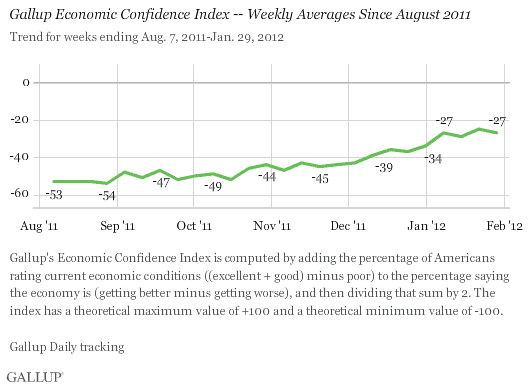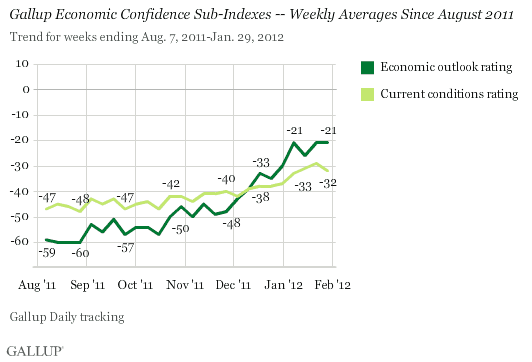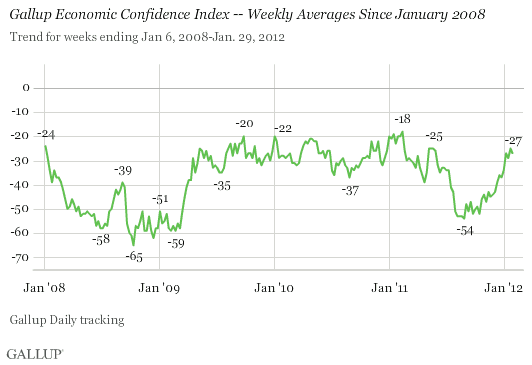PRINCETON, NJ -- The ÆéûÜǨû§Economic Confidence Index was -27 for the week ending Jan. 29, similar to the average rating in each of the prior three weeks. Confidence is up compared with December, and much improved over the highly negative readings of last fall and late summer.

Weekly economic confidence remains at its highest level since last spring, but is still lower than it was a year ago. The index had descended to -54 -- its lowest reading of 2011 -- in August. Confidence rebounded slightly in September, but showed steadier improvement from October through early January.
Economic Optimism Expanding Faster Than Positive Views of Current Conditions
Most of the gains in the overall Economic Confidence Index since the summer have occurred in the outlook component, which has risen from -60 in late August to -21 in late January. These index values are based on the percentage of Americans who believe the economy is improving minus those saying it is getting worse. Over the same period, consumer perceptions of current economic conditions (the percentage rating them "poor" subtracted from those rating them "excellent" or "good") have improved by about half as much, from -48 to -32.
The momentum in both components of the index has largely stalled in January, albeit at or near recent highs.

The overall ÆéûÜǨû§Economic Confidence Index is now on par with where it stood in late May, prior to the and that contributed to a downward spiraling of confidence last summer.
Longer term, Americans' economic confidence at the start of 2012 is not quite as upbeat as it was a year ago, but is comparable to confidence in January 2010 -- at the start of President Obama's second year in office -- and in January 2008, prior to the global financial collapse. Confidence today is far better than in January 2009, when the country was still reeling from the Wall Street crisis and the government's response to it.

Bottom Line
Gallup's weekly Economic Confidence Index readings show that confidence continues to be up in January compared with December -- likely foreshadowing the Conference Board's January consumer confidence report. However, that gain was largely in place in early January, and confidence has since been flat.
Earlier this month, ÆéûÜǨû§noted that the Economic Confidence Index had been improving by an , and that if it continued on that trajectory, confidence would rise into positive territory -- -- by April. Positive and reports may have lifted confidence around New Year's; however, without further good news, it has since stabilized, making that climb out of negative confidence more uncertain.
Gallup's full historical trends on economic confidence (with monthly readings from October 2000 through December 2007, and less frequent readings from 1992 through late 2000) show that Americans were solidly positive about the economy at various points over the past two decades, but that since 2008, there has been a ceiling at about -20. To finally break through that, consumers may need to see sustained improvements in unemployment, accompanied by no major setbacks at the gas pump, on Wall Street, in the housing market, or in other sectors.
Gallup.com reports results from these indexes in daily, weekly, and monthly averages and in Gallup.com stories. Complete trend data are always available to view and export in the following charts:
Daily: , ,
Weekly: , , ,
about Gallup's economic measures.
our economic release schedule.
Survey Methods
Results are based on telephone interviews conducted as part of ÆéûÜǨû§Daily tracking Jan. 23-29, 2012, with a random sample of 3,508 adults, aged 18 and older, living in all 50 U.S. states and the District of Columbia.
For results based on the total sample of national adults, one can say with 95% confidence that the maximum margin of sampling error is ôÝ2 percentage points.
Interviews are conducted with respondents on landline telephones and cellular phones, with interviews conducted in Spanish for respondents who are primarily Spanish-speaking. Each sample includes a minimum quota of 400 cell phone respondents and 600 landline respondents per 1,000 national adults, with additional minimum quotas among landline respondents by region. Landline telephone numbers are chosen at random among listed telephone numbers. Cell phone numbers are selected using random-digit-dial methods. Landline respondents are chosen at random within each household on the basis of which member had the most recent birthday.
Samples are weighted by gender, age, race, Hispanic ethnicity, education, region, adults in the household, and phone status (cell phone only/landline only/both, cell phone mostly, and having an unlisted landline number). Demographic weighting targets are based on the March 2011 Current Population Survey figures for the aged 18 and older non-institutionalized population living in U.S. telephone households. All reported margins of sampling error include the computed design effects for weighting and sample design.
The questions reported here were asked of a random half-sample of respondents for seven nights on the ÆéûÜǨû§Daily tracking survey.
In addition to sampling error, question wording and practical difficulties in conducting surveys can introduce error or bias into the findings of public opinion polls.
For more details on Gallup's polling methodology, visit .
